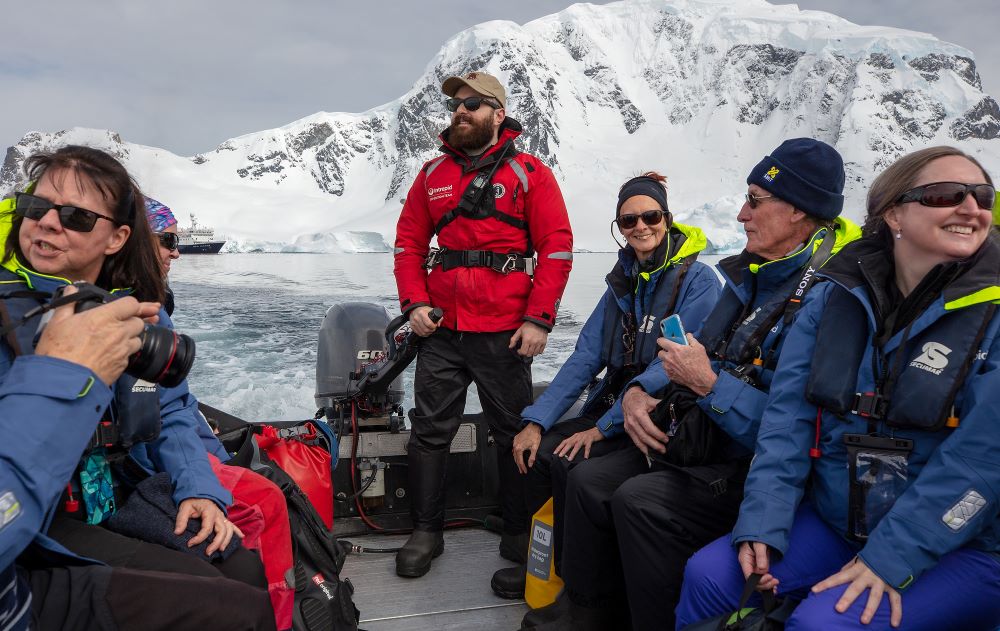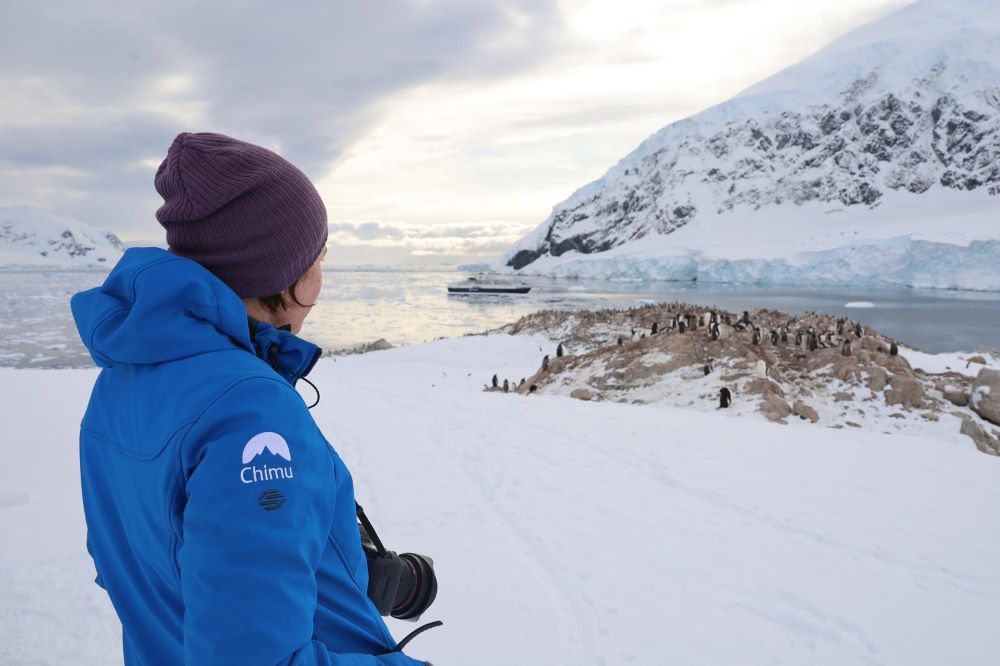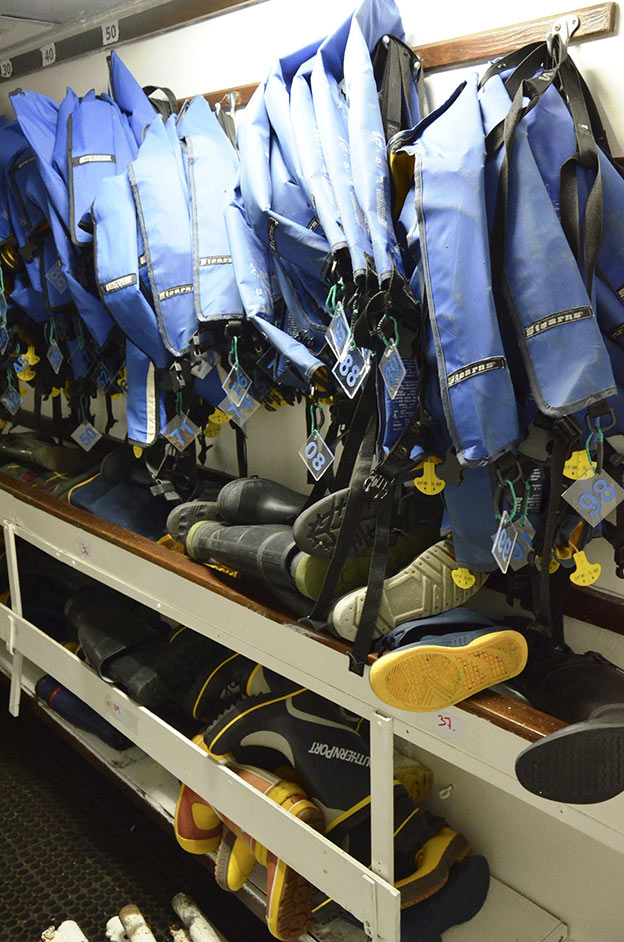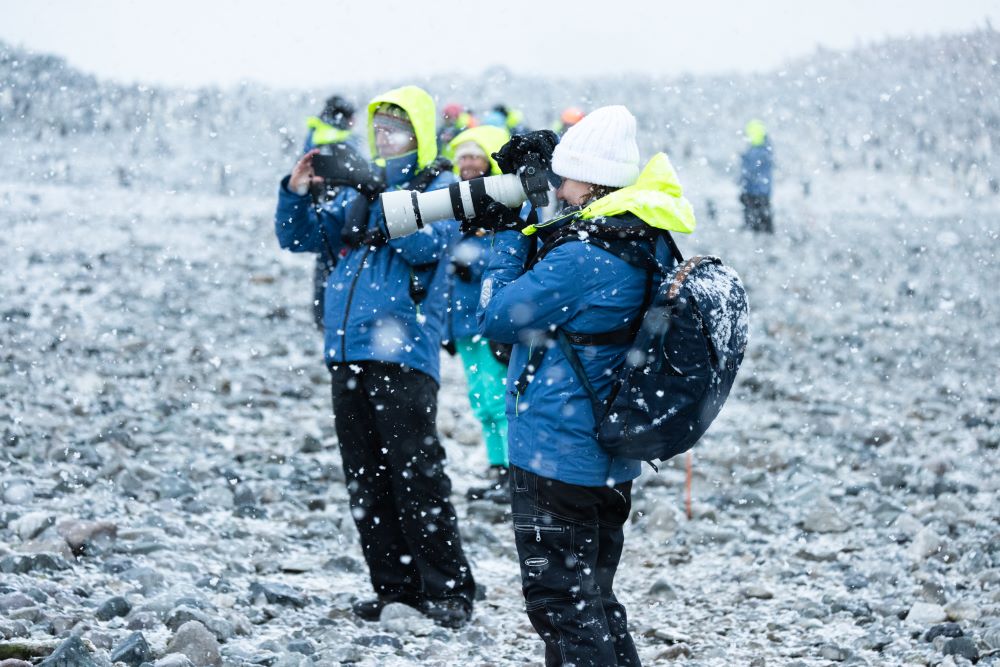Your Essential Antarctica Packing List
What should you pack for an exhilarating adventure to the end of the world? Read on to find out!
Putting together your essential packing list for Antarctica may seem to be an overwhelming task at first and can certainly take all the romance out of the anticipation of your soon-to-be ‘trip of a lifetime’. We’d love to tell you to ‘chill right out’ (pun totally intended): preparing for an Antarctic adventure expedition isn’t all that difficult, especially when you have a packing guru (that would be us) guiding you all the way to our southern frozen frontiers.
Before we divulge our essential Antarctica packing list, we’d love to share some insider info that we think you’ll find very useful. For, as they say, knowledge is half the packing-war won!

Your #1 climate enemy in Antarctica is not the cold…it’s the wind
At the height of the Austral summer, Antarctica won’t be nearly as cold as you may imagine; at least, not the kind of eyeball-freezing-cold you’re probably dreading. If you’ve ever spent a white winter in Europe or a week skiing in Thredbo in July or hey, maybe you live in Canada, you will inarguably have experienced colder temps.
Low temps aren’t really an issue if you’re properly dressed (more on what to wear below) yet freezing winds can undo all the good layering if you allow for too much skin exposure. Your #1 priority when exploring Antarctica is to be protected from the wind, first and foremost.
The climate in Antarctica is CRAZY unpredictable
Much like onions, guests aboard Antarctica expedition ships can often be seen shedding and reapplying layers every ten minutes, all thanks to the unpredictable and erratic climate this far south. Being prepared for all eventualities is the key to enjoying an on-land excursion in Antarctica, where you’ll be far from the comfort of your ship’s heated indoors.
No matter what the day looks like as you disembark, expect the weather to change suddenly. Be a clever packing ninja, and you’ll be just fine.
Watch out for water spray, it can be brutal
The seas have a lovely mitigating effect on temperatures so you’ll never be as cold cruising Antarctica’s coast as if you were in the heart of the continent, near the South Pole. Having said that, being splashed with water and exposed to high winds (as one usually is on a Zodiac outing) will certainly make it seem as if it’s 20 degrees colder.
Transfers on Zodiacs are exhilarating and fun, yet these are the times when you’ll be at your most vulnerable. Cover up well for Zodiac transfers, no matter the conditions: the last thing you’ll want is to land on Antarctica, with soaking wet beanie, gloves or pants.

Don’t be sucked into the ‘extreme’ activewear trend
Go into a trendy outdoor shop nowadays and you’ll see all sorts of gear aimed at extreme expeditions: sleeping bags and jackets able to stand -40C temps and all sorts of gadgetry that’s guaranteed not to freeze before you do. On an Antarctica cruise, you won’t be needing any of that. Sensible warm clothing is a must, but over the top gear that weighs twice as much as you do, is not.
Good-quality waterproof outer layers are an absolute must
These are your best friends, your protectors and the items of clothing you will wear more than any other. Well, aside from underwear, perhaps. A waterproof and windproof jacket and pair of pants are an absolute must, although you should make sure they are relatively thin and can be worn OVER your normal fleece and cargo pants/jeans.
Your jacket should have a high collar to protect your neck as that’s where you’ll lose most of your body warmth. Same goes for boots: lightweight yet warm and waterproof is what you should be packing. Do note that many Antarctica expedition ships will provide outer layers for their guests – enquire at booking and you may just shave off a few items from your packing list.

Skip the thick woolly thermal onesies
We understand that cunning-you wants to invest in a Norwegian-made woollen thermal onesie made for winter sailing but aside from the fact that no one wants to look like an overgrown Teletubby, wearing thick woollen thermal wear is actually counterproductive on an Antarctica cruise, for several reasons.
First of all, temps on the Antarctic Peninsula in mid-summer can easily reach 5C (or -5 at the beginning or end of season) hardly cold enough for that kind of bulky thermal wear and, coupled with lots of physical movement on your part (boarding and alighting Zodiacs and on-land hikes), you’ll find yourself overheating in no time. A one-piece thermal suit is just about impossible to remove quickly (and decently in public), and that’s where layering your clothing really pays off.
You need to remover a sweater? Done in 2 minutes. Get completely undressed so you can remove your thick woollen long-johns? Not so fast…
Layer up!
The most essential aspect of packing to Antarctica is ensuring you have layers which can easily be worn simultaneously. This is, by far, the best course of action. Given the unpredictability of the weather, you can be cold and warm and then a bit too warm and then very cold, all in just a couple of hours. Layers are the only thing that’ll help you cope with that.
But not too bulky!
By the time you board your Zodiac, you will ideally be wearing three or four layers of clothing. If your layers are too bulky, it’s easy to imagine how difficult movement might be. Being agile is a must on Antarctica cruises, so make sure layers work together to keep you warm whilst still allowing for full-body movements.
Except for socks: those should be thick, woollen and plentiful
‘You can’t have too many pairs of socks’, most Antarctica travel experts will tell you and for very good reasons. There is arguably nothing worse on Antarctica excursions than getting your socks soaking wet and not having a clean, warm pair to change into. Moreover, the gumboots you’ll be given onboard your expedition ship aren’t insulated so your socks will have to be extra warm.
Pack plenty of woolly socks and always keep a spare pair in a ziplock bag, in your daypack, whenever you head off the ship.

Sunglasses will protect you from the overwhelming glare
Ever heard of snow blindness? It’s a real thing, and it totally sucks. Protect your eyes against the incredible glare which reflects off the ice in Antarctica. A pair of wraparound UV-protected sunglasses is the best choice.
Consider your camera equipment carefully
Not everyone who cruises to Antarctica is a budding photographer but, once there, everyone wishes they were. The only mistake many make, however, is taking far too much camera equipment, most of which ends up weighing them down. Keeping your daypack light is essential, so we suggest you take a good-quality DSLR with interchangeable lenses for both landscape and close-up photography.
Consider a hood for your viewfinder (the glare can make it impossible to see otherwise) and, if you’re not too confident, just make sure your camera has an ‘auto’ function. Taking a tripod? Make sure it folds to nothing and weighs like a feather. And if you don’t want to deal with any of that, do note that late-model smartphones can take some seriously wicked photos in Antarctica. See this Conde Nast Traveller article for other cool stuff you need not worry about.
Choose a small, waterproof daypack
You’ll need a daypack for day-long outings so you can carry your water, sunscreen, extra camera batteries, spare socks etc BUT it should be small, compact, and waterproof. A daypack should never be heavy, certainly not heavy enough that it affects your posture. Keep it light and supple and it’ll save you much back-ache.
Consider using a cold-weather moisturiser on your trip
If you’ve lived or travelled to cold countries before, you may be familiar with ‘cold creams’ which are moisturisers specifically designed to not freeze on your skin in very cold temps. If you have dry or particularly sensitive skin, these can be a godsend on Antarctica cruises.
Now that we have the most important tidbits of info out of the way and you understand the basics that’ll make your life easy and comfortable on an Antarctica cruise adventure trip, you can move on to your essential Antarctica packing list.
Print this out and stick it on your fridge: it’s essential Antarctica packing time!
Ultimate Antarctica Packing List
‘Normal’ walking shoes
For the time you spend on the ship and those sightseeing days in towns before and after your cruise.
Comfortable onboard clothing
Casual and lightweight clothing is ideal for hours spent on the climate-controlled ship.
Toiletries
Sunblock is an absolute must, as are Chapstick, a nourishing moisturiser and all usual essentials you’d normally pack for a long-haul flight. Nothing more.
Earplugs
Especially if you’re a light sleeper – expedition ships can be noisy environments as interior walls are not all that soundproof.
Expedition clothing
Cargo pants: Cargos and tracksuit pants are great options to be worn under your wet-weather gear. We find jeans a little too restrictive, although any pair of comfortable walking pants will do. Fight the urge to take stretchy pants, however, as you’ll want plenty of air pockets in all your layers to allow for better insulation.
L/Sleeve tops: 3 x tops should do the trick on a two-week expedition cruise
Polar fleece zip-jacket: That divine warm layer between your long-sleeve top and your parka
Thin thermal pants and top: Warm undergarments are great as they take up little space but can add quite a few degrees of warmth.
A tight-fitting beanie, neck warmer & gloves
Ideally, you should wear two pairs of gloves: a thin pair with which you can operate your camera and get things out of your day-pack, and an outer waterproof pair that’s thick and warm and will keep your hands dry if you accidentally end up face-palming the ice. It’s been known to happen. A woolly beanie is a godsend, and one with ear flaps particularly so, even if your outer jacket has a hoodie.
Binoculars
Binoculars are fantastic to have when wildlife spotting from the ship’s viewing terraces. Although many wildlife encounters are up-close in Antarctica, some will not be.
Medication
Whatever your usual medication is, as well as Ibuprofen, Aspirin and sea-sickness tablets (just in case). Pack a spare pair of sunglasses/reading glasses too– Trust us on this: even if you’ve never sat on a pair of glasses in your entire life, chances you will do so in the one place on earth where you can’t get a replacement, are huge. It’s Murphy’s Law. Play it safe and bring spares.
Camera equipment
Decided what to take? Now don’t forget to pack it! Extra SD cards and batteries are essential too, so don’t hold back, the penguins and seals aren’t shy! You will be taking infinitely more photos than you may imagine, so always have spare cards and batteries in your daypack and make sure to recharge everything at night
Books, crossword puzzles, media device
There will always be plenty of time to chill out and unwind on Antarctica cruises so packing some light personal entertainment is a really good idea
Heavy-duty water bottle
There are places onboard where you can refill your reusable water bottle, making this the best option for staying hydrated on your cruise.
Gear Rental
If you don't think you will need your expedition gear after the cruise, perhaps consider renting it! There is a rental shop located in Ushuaia that will let you book your specialist gear, try it on when you get there and hand it back when you return! Saves on worrying about baggage weight restrictions, and is also a lot cheaper than buying it all. Simply visit This shop, put in the details of your voyage, and it will be waiting for you on arrival to Ushuaia. Just make sure you book it at least 7 days prior to your trip.
We may not be able to do the actual packing for you but we do hope our essential Antarctica packing list will make your job a whole lot easier.
Still looking for that perfect journey to join, see our exciting range of Antarctica Cruises and contact us, at any time, to know more.

Frequently Asked Questions
Q1. Will my Antarctic cruise include boots and a parka?
Many Antarctic operators offer waterproof boots, known as muck boots, and a waterproof parka on loan during your cruise. Some companies may also offer a puffy inner jacket that's yours to keep. Your Chimu representative or travel agent can provide more information at the time of booking.
Q2. Should I bring hand warmers to Antarctica?
With insulated waterproof gloves, your hands and fingers will stay cosy and warm! We actually recommend against disposable hand or toe warmers, as they have negative implications for the environment and aren't necessary.
Q3. Where do I store my wet gear after returning to the ship?
Many Antarctic ships offer a mudroom. You'll have your own assigned locker where you can stow your wet or icy gear, so that you don't have to bring it upstairs to your cabin. The mudroom is also a great place to put on or take off your outer gear, as they are spacious and have benches for putting on your boots comfortably.
Where Will You Go Next ?
- Popular Destinations
- Antarctica
- The Arctic
- South America
- Central America
- More to explore
- Amazon
- Antarctic Circle
- Antarctic Peninsula
- Argentina
- Bolivia
- Brazil
- Canadian Arctic
- Chile
- Colombia
- Costa Rica & Panama
- East Antarctica
- Ecuador
- Galapagos Islands
- Greenland
- Guatemala & Honduras
- Machu Picchu
- Mexico
- Patagonia
- Peru
- South Georgia and Falkland Islands
- Spitsbergen
- Sub Antarctic Islands

Talk to one of our experienced Destination Specialists to turn your Antarctic, Arctic and South American dream into a reality.
Contact us

 We Value Your Privacy Settings
We Value Your Privacy Settings